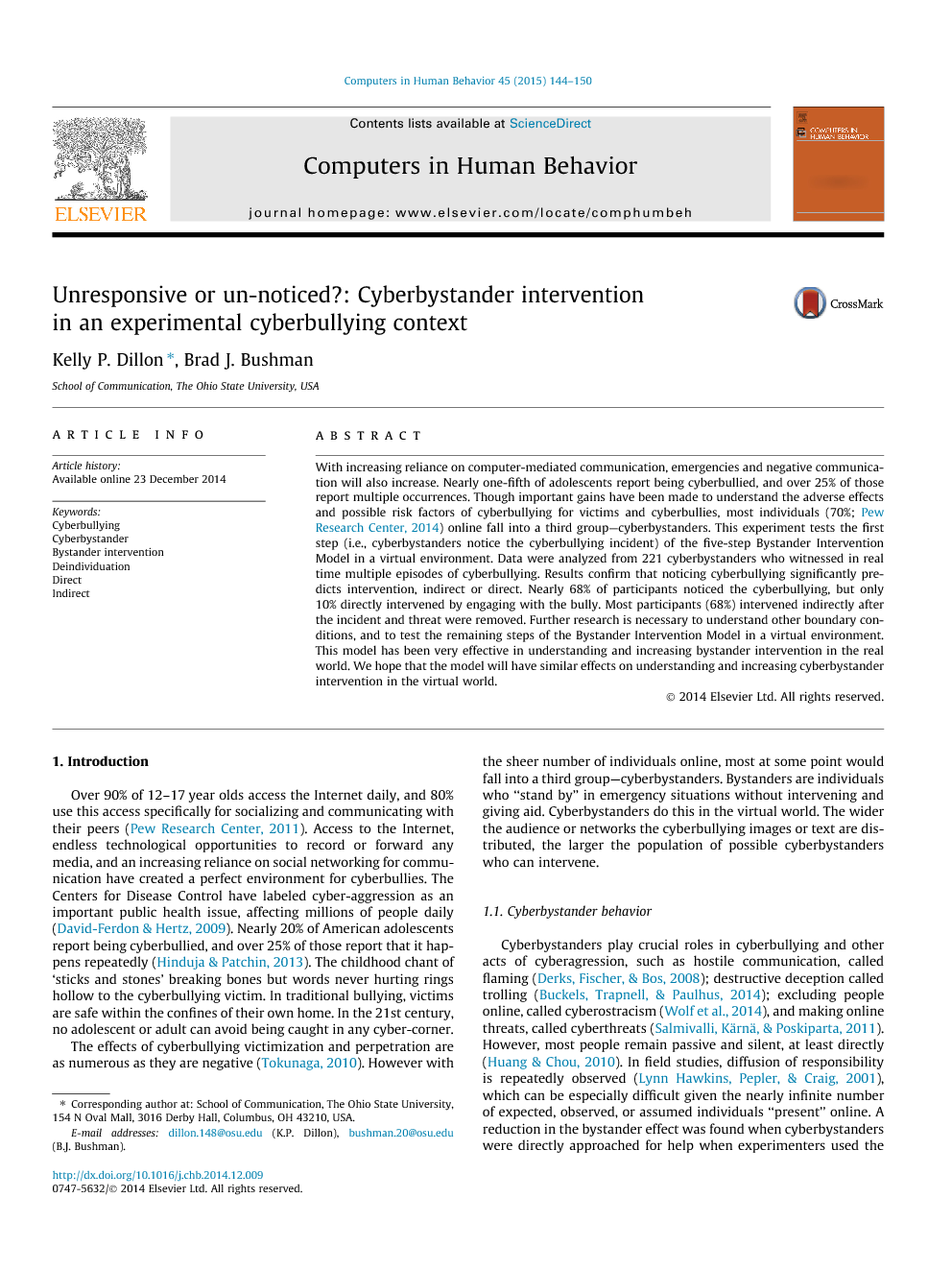With increasing reliance on computer-mediated communication, emergencies and negative communication will also increase. Nearly one-fifth of adolescents report being cyberbullied, and over 25% of those report multiple occurrences. Though important gains have been made to understand the adverse effects and possible risk factors of cyberbullying for victims and cyberbullies, most individuals (70%; Pew Research Center, 2014) online fall into a third group—cyberbystanders. This experiment tests the first step (i.e., cyberbystanders notice the cyberbullying incident) of the five-step Bystander Intervention Model in a virtual environment. Data were analyzed from 221 cyberbystanders who witnessed in real time multiple episodes of cyberbullying. Results confirm that noticing cyberbullying significantly predicts intervention, indirect or direct. Nearly 68% of participants noticed the cyberbullying, but only 10% directly intervened by engaging with the bully. Most participants (68%) intervened indirectly after the incident and threat were removed. Further research is necessary to understand other boundary conditions, and to test the remaining steps of the Bystander Intervention Model in a virtual environment. This model has been very effective in understanding and increasing bystander intervention in the real world. We hope that the model will have similar effects on understanding and increasing cyberbystander intervention in the virtual world.
Over 90% of 12–17 year olds access the Internet daily, and 80% use this access specifically for socializing and communicating with their peers (Pew Research Center, 2011). Access to the Internet, endless technological opportunities to record or forward any media, and an increasing reliance on social networking for communication have created a perfect environment for cyberbullies. The Centers for Disease Control have labeled cyber-aggression as an important public health issue, affecting millions of people daily (David-Ferdon & Hertz, 2009). Nearly 20% of American adolescents report being cyberbullied, and over 25% of those report that it happens repeatedly (Hinduja & Patchin, 2013). The childhood chant of ‘sticks and stones’ breaking bones but words never hurting rings hollow to the cyberbullying victim. In traditional bullying, victims are safe within the confines of their own home. In the 21st century, no adolescent or adult can avoid being caught in any cyber-corner.
The effects of cyberbullying victimization and perpetration are as numerous as they are negative (Tokunaga, 2010). However with the sheer number of individuals online, most at some point would fall into a third group—cyberbystanders. Bystanders are individuals who “stand by” in emergency situations without intervening and giving aid. Cyberbystanders do this in the virtual world. The wider the audience or networks the cyberbullying images or text are distributed, the larger the population of possible cyberbystanders who can intervene.
1.1. Cyberbystander behavior
Cyberbystanders play crucial roles in cyberbullying and other acts of cyberagression, such as hostile communication, called flaming (Derks, Fischer, & Bos, 2008); destructive deception called trolling (Buckels, Trapnell, & Paulhus, 2014); excluding people online, called cyberostracism (Wolf et al., 2014), and making online threats, called cyberthreats (Salmivalli, Kärnä, & Poskiparta, 2011). However, most people remain passive and silent, at least directly (Huang & Chou, 2010). In field studies, diffusion of responsibility is repeatedly observed (Lynn Hawkins, Pepler, & Craig, 2001), which can be especially difficult given the nearly infinite number of expected, observed, or assumed individuals “present” online. A reduction in the bystander effect was found when cyberbystanders were directly approached for help when experimenters used the cyberbystander’s name (Markey, 2000). These participants, however, are no longer bystanders when directly approached, and become active participants in the emergency. In another study (Barlińska, Szuster, & Winiewski, 2013) harassing photographs of a schoolmate were sent to a few adolescent peers. Participants (the recipients of these photographs) had options to report the harassment, forward the photographs, or tell the individual what wasn’t right about their actions. The researchers found that when given the opportunity to engage as an active participant in forwarding harassment, cyberbystanders are more likely to do so online than offline. These participants could be considered more passive recipients than traditional bystanders.
Future research is necessary to understand the decision processes of cyberbystanders who directly intervene compared to those who employ indirect interventions. It is possible specific moral disengagement strategies, such as displacement of responsibility (e.g., it is not my job), moral justification (e.g., this is typical for the Internet), and euphemistic labeling (e.g., it is only words) are utilized by cyberbystanders to explain non-intervention. In the present study, the number of cyberbystanders was kept consistent and the cybervictim never addressed the cyberbully or any direct intervened. It is possible cyberbystanders, like bystanders offline, rely on victim communication or reactions of others in order to interpret the situation. The cyberbystanders in the present study may not have directly intervened because they did not have the necessary information to interpret the cyberbullying as an emergency needing intervention. We are currently testing this threshold and the decision strategies used by cyberbystanders. Other experiments testing the subsequent steps in the Bystander Intervention Model are also underway.
In one survey, over 90% of adults 18–60 and 93% of teens and adolescents reported using communication technologies and their daily interactions (Lenhart, Purcell, Smith, & Zickuhr, 2010). This access affords users the opportunity to serve as cyberbystanders to a variety of negative cyber-events. More investigation is necessary, but in the 21st Century this initial study can serve as a good first step towards understanding useful and accessible strategies to combat cyberbullying.


